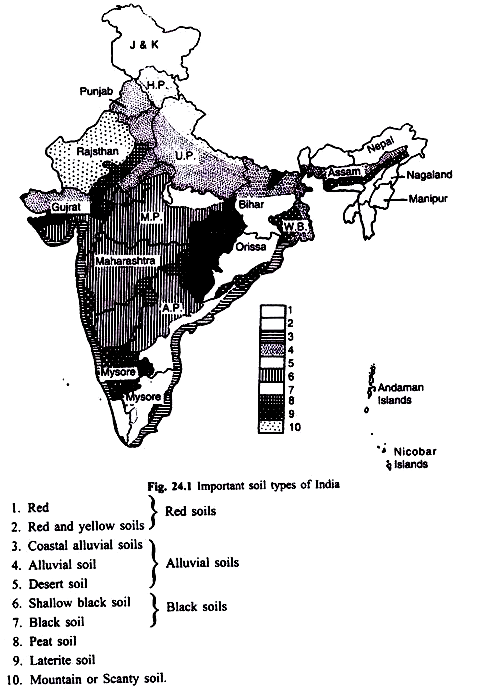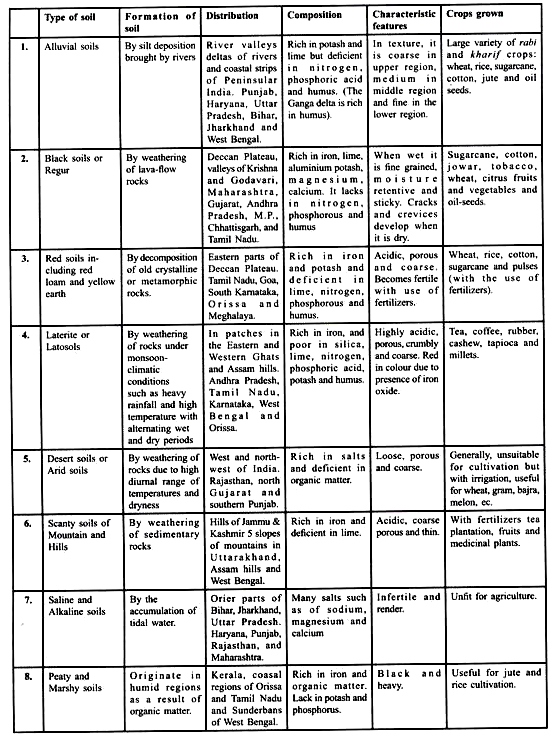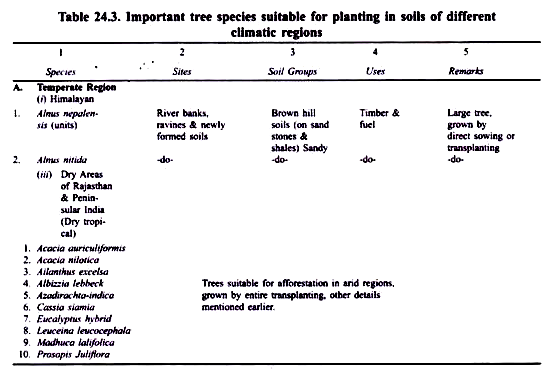1. Laterite or Lateritic Soils or Latosols:
Laterite is generally reddish or yellowish red in colour which turns black on exposure to sun.
This group of soil occupies belts of various widths around the peninsular zone.
Such soils occur on the plateau of Malwa, Madhya Pradesh, Central India, Bihar, Orissa, Tamil Nadu, Eastern and Western Ghats, Assam, Bengal, Hyderabad covering a total area of about 2,48,000 square kilometers.
Origin of lateritic soils is still a matter of dispute. Important rocks which produce such soils are greisze, sand stone, basaltic rocks and granite. These are residual or sedimentary rocks. Laterites are formed in the region of high rainfall and with alternating wet and dry seasons.
When the alkali and silica are leached away the residual compounds rich in aluminium and iron oxides form such soils. Lateritic soils are compact and composed of hydrated oxides of aluminium and iron with small amount of manganese and titanium oxides. When soil is broken and earned to lower levels by water it again becomes cemented into compact indurated honey-combed mass.
Lateritic soil is usually poor in lime, magnesia, nitrogen, phosphate, and potash. Humus is present in abundance in this soil. Base exchange capacity is low. Soil is good for agriculture purpose. Valley soils can produce good crops of rice and sugar cane whereas at higher elevations such soils favour the growth of coffee, rubber, tea, cinchona etc.
2. Black Cotton Soils or Regur (Regada = Black):
These soils are black in colour and best suited for cotton cultivation. It is locally known as regur in some provinces. Black soils are distributed in Tamil Nadu, South-east Mumbai, Eastern Hyderabad, Maharashtra, Western M.P., parts of Mysore, Andhra Pradesh, Gujarat Southern districts of Orissa, Bundi and Tonk districts of north Rajasthan, and Bundelkhand region of UP. Covering total area of approximately 5, 46,000 square kilometres. The soil is derived from Deccan and Raj Mahal trap rocks and ferruginous gneisses and schists in Chennai.
According to Theofold, the black soil is associated with Deccan trap. Apparently, it is derived by the decomposition of trap rocks and its blackish colour is due to presence of superficial iron in the rocks. According to Hislop, it is of sub-aerial origin or it has been formed by the alternate deposition of organic soil and the primary deposition of weathering products of almost all the rocks According to some other workers, it is produced by assimilation of humus of different argillaceous soils derived from the decomposition of trap rocks.
According to Ramaswamy Sivan, it is formed due to accumulation of black coloured light soil particles. The surface fraction consists of small transparent or semi-transparent grains cemented together by dark coloured matrix which is a mixture of double hydrated ferrous and aluminium silicate.
The colour of regur soil varies from place to place. Regur soils are mostly dark grey to black in colour. The soil is clayey (clay content 40-60%) or loamy or sandy loams. The soil is characterised by high percentage of calcium and magnesium carbonates, iron oxides and alumina It is sticky in wet condition and contracts on dying resulting in cracks or heavy fissures. The soil is poor in phosphorus and rich in nitrogen and organic matter.
Black soil is very productive. Water retaining capacity is much high. The base exchange capacity is also very high. Among the crops, cotton is the best suited. Other crops suited to black soils are wheat, millet, gram, pea, etc. The soil requires proper irrigational facilities. Black soils have been categorized into different groups which are based upon the depth of their formation.
These groups are:
(i) Shallow black soils (Depth ranges from 30 to 50 cms):
These soils are derived from basalts of Deccan trap.
(ii) Medium black soils (Depth ranges from 50 to 120 cms):
They are derived from a variety of rocks including basaltic trap, Dharwar schists, basic granites, gneisses, hornblende and chloride schists.
(iii) Deep black soils (Depth ranges from 120 to 200 cms):
These are derived from basaltic traps in Deccan plateau and are commonly identified as “regur soils” Distribution of irregular nodules of lime (Kankar) throughout is regular feature of this subgroup of black soil. ”
3. Red Soils Including Red Loam and Yellow Earth:
These soils are distributed in India mainly in the peninsular regions. The soils occur mainly in M.P., S.E. Mumbai, Mysore, Andhra Pradesh, West Bengal, Assam, Orissa, Chhota Nagpur covering a total area of about 3,50,000 square kilometres. Red soils are also found in some parts of Bihar and in Mirzapur, Hamirpur, Banda and Jhansi districts of U.P. and territory of East Aravali hills in Rajasthan.
The red soils develop from metamorphic sediments of granite gneisses and schists. The red soils of valleys and plains are dark and fertile. These are composed of silica and aluminium with free quartz or sands. Soils are low in bases and base exchange capacity. These soils are characterised by absence of lime nodules (Kankars). Percentages of humus and other organic nutrients are very poor in red soils.
The colour of red soil is due to high Proportion of iron compounds. Ferrous oxide is precipitated after evaporation of water from the soil. They are neutral to acidic in their reaction. Soils are generally rich in potash but nitrogen contain is low. The red soils are light, friable and porous. Their water-absorbing capacity is very low Cultivation on such soils depends upon irrigation and rainfall.
4. Alluvial Soils including Deltaic Coastal and Inland Alluvium or Alluvial Soils of Indogangetic Plains and River Basins:
It is the largest soil group in India covering a total area of about 15, 00,000 square kilometres. The soils are immature and can be divided into two geological groups namely old and new alluvial sub-divisions. The old alluvial soils, also called ‘Bangar’, are the soils of uplands and are composed of massive clay or compact silt. These are mixed with sands and kankars or lime nodules and are pale brown or dark in colour. The old alluvial soils are in the process of denudation. The new alluvial soil group, also known as Khadar, is sandy with less kankars. It is light in colour.
The soil is best suited for agriculture provided rains occur regularly. Alluvial soils are suitable for cultivation of wheat, rice, cotton, maize, millet, oils, sugarcane, groundnut, vegetables and jute. The various kinds of alluvial soils have same origin. They are formed from the materials transported by rivers over long period of time. These soils are found in Rajasthan, Punjab, Haryana, the valleys of Brahmaputra in Assam; Narmada and Tapti rivers in M.P.; Godawari, Krishna and Kaveri in the south, Yamuna, Ganga and their tributaries; Gandak, Gomati, Ghagra and others in U.P, Bihar, West Bengal and Jharkhand.
The soils of dry regions are rich in K, P and alkalies. CaO and FeO are present in varying amounts. In Brahmaputra and Ganga valleys and Assam plains, the great Khadar is low in lime, K and Mg contents. In dry regions of India, alluvial soils contain KNO3 and alkali in excess. Scanty rainfall, high temperature and natural drainage are chief conditions which result in the accumulation of salts in the form of underground obstructions and impervious clay pans which inhibit the leaching. These factors are also responsible for the development of barren land (usar) which is useless for cultivation.
The deltaic soils of Ganga and Brahmaputra are rich in humus and are loamy and hence they are fertile. But by floods, surface soils are removed and also replaced by fresh silty soils. This induces the soil fertility. Alluvial soils of peninsular regions including those of Narmada and Tapti valleys are very fertile. In Eastern Ghats, the deltaic soils of Godawari, Krishna and Kaveri rivers are black, humid and sandy. The soils of Orissa are sandy and swampy with fine texture. They are rich in potash.
Soils of Chennai are transported by rivers and consist of alternate layers of sands and silts. The alluvial soils of Gujarat, locally known as Goradu, consists of brown clay and kankars. Soils are poor in organic content and nitrogen but rich in potash. Such soils are very common in north Gujarat and Ahmedabad.
Yellow and red alluvial soils of M.P. are found in the Basin of Mahanadi River covering Balaghat, Durgapur, Raipur and Bilaspur districts. These soils are grouped as Bhata, Matasi, Dorsa, and Kanhar as these are found at different altitudes.
Comparative Account of Soils in India (ICAR):
Bhata is barren soil consisting of red gravels and sands. This is found on uplands.
Matasi is yellow loamy clay soil.
Dorsa is dark coloured clay soil of slopes.
Kanhar is darker and heavier than Matasi and Dorsa and is deposited in low lying areas.
The alluvial soils of U.P. are divided into the following four regions:
(a) Alluvial soil of West and North U.P. (light texture)
(b) Alluvial soil of East U.P. (heavy texture)
(c) Alluvial soil of Central region consisting of old alluvium which is neither too light nor too heavy, i.e., this is intermediate in texture.
(d) Alluvial soil of north-east U.P which contains CaCO3 and other salts and shows alkaline reaction.
5. Saline Soils and Alkaline Soils:
In these soils, percentage of salts is very high. These soils are distributed in Kanpur, Lucknow, Hardoi, Unnao, Raibareli, Azamgarh and many other districts of U.P., Punjab, West Bengal, Bihar, Orissa, Maharashtra, Tamil Nadu, M.P., A.P., Gujarat and Delhi covering an area of about 70,00,000 hectares. Some soils are salty mainly due to presence of alkali salts in them. They are called alkali soils. In some soils salts other than alkali are present. These are commonly referred to as saline soils or non-alkali saline soils. Alkali soils are barren and are also called usars in Hindi. The detailed accounts on saline and alkali soils have already been given in the chemical properties of soils.
6. Peaty and Marshy Soils of Forests:
Peaty soils are also known as peaty saline soils. At some places it is called Kari. The peaty soils are peculiar blue coloured soils. The waterlogged peaty soils appear in the low lying submerged areas. They are also termed as marshy soils. The peculiar colouration is due to presence of free aluminium and ferrous compounds. Organic matters are accumulated in poorly decomposed conditions on account of the lack of oxidation and poor drainage conditions.
Peaty soils are distributed in coastal tracts of Orissa, West Bengal (in Sunderban), North Bihar, Almora in Uttaranchal, S.E. Tamil Nadu and Kerala covering an area of about 150 square kilometres. Soils are rich in humus and are acidic. Sometimes water soluble alkali salts are also accumulated in the soils. During monsoon period these soils are flooded with water.
7. Desert Soils or Arid Soils:
Desert soils are commonly found in arid and semi-arid zones in India, e.g., North-Western Rajasthan and South Punjab (between Indus river in west and Aravali hills in the east) and semi- arid area of Rann of Kutch covering a total area of about 1,42,000 square kilometres. In arid area, rainfall is very poor (up to 62.5 cm) and temperature goes very high during the summers. The soils in these areas are coarse textured regosols and wind moved sand and sand-dunes. Soils are salty and they contain good amount of alkalies and humus content.
Their water holding capacity is very low. At several places due to poor rainfall soils become barren but they can be reclaimed to normal conditions provided irrigational facilities are available. The scarcity of water and excessive accumulation of saks make the soils unfit for cultivation. This is why vegetation is very poor, forests are totally absent and desert is spreading progressively eastward in Rajasthan.
Considerable attention is being given these days for checking desertification and for converting the desert land into fertile area. Recently Central Arid Zone Research Institute, Jodhpur, has recommended the stabilization of sand by growing thick vegetation in the area. Central Arid Zone Research Institute has further recommended the cultivation of many indigenous and exotic varieties of trees, grasses and salt tolerant species which grow in desert conditions. Important plants well suited to desert land are Calligonum polygonoides, Leptadenia, Crotolaria, some grasses and herbs like Citrulus, Rhynchosia, etc. Some trees of deserts are Prosopis, Acacia, Albizzia lebbeck, Dalburgia sisspo, etc.


